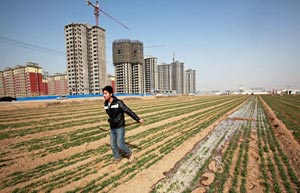Chinese farmers look to more land reform
(Xinhua) Updated: 2014-02-26 17:33A reform master plan approved at the session promises to give the country's 650 million rural residents more property rights, but specific measures have yet to be announced. Farmers expect such measures to be discussed during the two sessions in March.
China's per capita arable land is only about 1.35 mu, lower than half of the world average. High-yield farmland only accounts for 30 percent of the total arable land and the country has few backup resources available, according to a State Council report.
To ensure grain security, the country has drawn a "red line" of 1.8 billion mu as the official minimum area of arable land needed to feed the world's largest population.
The central leadership has reiterated its resolve to carry out the reform master plan in the lead-up to the two sessions.
When addressing a workshop attended by principal officials at the provincial and ministerial levels last week, President Xi Jinping said that "drafting a good document is only the first step for a long march, and implementation is still the key."
Wang Zhongwu, a sociology professor at Shandong University, said that regional development disparities and "unbalanced, uncoordinated and unsustainable development" will still be hot topics during the two sessions.
Wang said that such problems cannot be resolved in a short time, adding that these troubles will test authorities' governance capabilities in the following years.
|
 |
 |
Two sessions eyed for local govt debt solution
- NHTSA says finds no 'defect trend' in Tesla Model S sedans
- WTO rare earth ruling is unfair
- Amway says 2014 China sales may grow 8%
- President Xi in Europe: Forging deals, boosting business
- CNOOC releases 2013 sustainability report
- Local production by Chery Jaguar Land Rover this year
- Car lovers test their need for speed in BMW Mission 3
- China stocks close mixed Monday

















